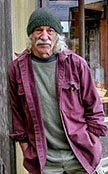Wow! First one of these I’ve seen. An electric mini car!
Charge it with solar panels…
Look at the video:


Wow! First one of these I’ve seen. An electric mini car!
Charge it with solar panels…
Look at the video:
South of Siracusa. The poured concrete spiral staircase is interesting. The dilapidated condition makes it look like it was built a long time ago.
A wonderful exhibit “…dedicated to the universal genius of Leonardo Da Vinci, in the heart of Florence.”

A (grainy) photo of the Shelter crew in my dome at lunch time, summer, 1973. L-R: Me, Joe Bacon, baby Chandra, Bob and Jeanine
In 1970, we took one week, borrowing the Whole Earth Catalog studio in the Santa Cruz mountains, and produced Domebook One. In 1971, we rented an old lakeside resort in the Santa Barbara mountains for a month and again, borrowing WEC typesetting and camera equipment, produced Domebook 2.
In 1973, Bob and his wife Jeanine and baby Chandra moved to Bolinas for three months while we worked on Shelter. I would write or edit text, Joe Bacon (“fastest typist in the west”) would do the typesetting, and Bob would design the pages. He did this by hand-drawing each two-page spread on architectural drafting paper, and the pages would be prepared accordingly. Analog book production.
Bob would edit me and we argued a lot, but it was an iterative process that fine-tuned the book.
We were both fans of Life Magazine, and felt that each two-page spread should stand alone and be visually balanced.
People tend to think of me as the sole producer of Shelter and Bob doesn’t get enough credit for what he did. Without him, Shelter would not exist in its graphically exciting and hip form. We were fans of all the changes of the ’60s and throughout the book, commented on old ways that should be cleared out for the new.
After Shelter, Bob went full-time into architecture, with an exception, being co-author, along with Peter Nabokov, of Native American Architecture.
Leonardo never built one, but apparently sketched one, along with a chain, in the 1500s. There’s a lot of controversy over who really designed the first bike.
The VW Pea (sorry, you can’t buy one — it was commissioned by Bird’s Eye for a commercial) It started out as a VW Microbus, but was modified into a pea.
The Pea car first appeared in a Birds Eye television advertisement in December, 2005.
London-based special effects company, Asylum, took six weeks to build the car using a heavily modified chassis from an off-road go-kart fitted with a Honda engine.
Weighing just 750kg, it was capable of 50mph/80.47kph even though it had no gears. Whilst bearing a Volkswagen resemblance, only the headlights were sourced from a beetle. The indicators are of Lancia origin, wing mirrors from a specialist shop and all other parts were made to order.
The advert showed the car driving straight from the farmer’s field but slowly losing its body parts along the road. The car reaches its destination as just a bare chassis. Then from the back of a refrigerated lorry emerges a brand new pea car. A voice over narrates how vegetables lose vitamins from the moment they are picked whereas Birds Eye peas are immediately frozen thus retaining essential vitamins.
Above from: retrokimmer.com/2015/12/the-vw-pea-car-story.html
I picked this up from Amy Sedaris’ Instagram account. She posts excellent stuff. @amysedaris
Lloyd,
Just looking at your blog and reminiscing. I’ll include my first house that was inspired by your first book. I built it in the woods outside Chapel Hill NC. I stretched burlap over the frames and sprayed it with watered-down cement. The area was many acres of owner-built alternative architecture. (The book “12 by 12” is about a little house that was on the next street over.) The funny thing about my little house is, years later I was traveling through the area and went by to see what it looked like. Astonishingly (to me), it had been turned into an upscale suburban sea of split-level homes but the one on my old lot had kept the little yurt and was using it for a pool house.
Since those days, I have built 6–8 houses; the most recent was in a community called City of the Sun in southern New Mexico primarily out of papercrete.
Thank you for all you have done to inspire countless dreamers.
–Bob Cook
Back in the ’60s, my architect hero was Bernard Maybeck who, along with architect Julia Morgan, designed a series of wonderful Bay Area buildings. One of Maybeck’s experiments was “Bubblestone,” making a wall by hanging burlap bags that had been “…dipped into a frothy mix of concrete and then hung, shingle-style, onto exterior walls.”
Reference for above quote: patch.com/california/berkeley/bp–architect-bernard-maybeck-and-his-experiments-witac2f59eef0